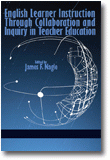
English Learner Instruction through Collaboration and Inquiry in Teacher Education
Edited by:
James F. Nagle, Saint Michael's College
Published 2013
In an era of accountability and increased demand of literacy competency, this book provides examples of how teacher educators and teachers have come together to learn from each other and from English learners. The chapters in this book follow a teacher learning framework that highlights joint work, features inquiry into practice and integrates disciplinary content knowledge with culturally and linguistically responsive teaching.
While the chapters feature different venues for teacher learning, they all depict the process of teachers and teacher educators striving to integrate English learner instruction into mainstream teacher education. This book will be a resource for faculty in teacher education programs and for administrative personnel in school districts to illustrate the process of building authentic collaborations that can improve teacher learning and understanding about English learner instruction.
CONTENTS
Introduction: A Teacher Learning Framework for All Teachers of English Learners, James Nagle. PART I: DISSOLVING TRADITIONAL BOUNDARIES. Reading, Writing, and Talking Science With English Learners, Luciana C. de Oliveira, Shu-Wen Lan, and Kathryn Dodds. Putting Grammar to Use, Elizabeth O’Dowd and Nancy Nadel. Exploring Writing With English Learners Through the Digital Story: A Collaborative Service Learning Approach, Cynthia Reyes and Bill Clark. Equal Partners: Teachers and Teacher Educators Learning Together in Professional Learning Communities, James Nagle and Rita MacDonald. PART II: INNOVATIVE COLLABORATIONS IN TEACHER EDUCATION. Collaboration Within a Teacher Education Program: Preparing History Teachers to Teach English Learners, Laura Schall-Leckrone and Patrick McQuillan. “Transitions”: Collaboratively Developing a Curriculum on Future Educational Choices for English Learners, Rabia Hos and Mary Jane Curry. The Role of an Online Discussion Board in Fostering a Critical Collaborative Learning Community in an ESL Specialist Credential Program, Vera J. Lee and Barbara Hoekje. PART III: FORWARD THINKING MODELS OF TEACHER EDUCATION. Bridging Barriers Between Higher Education and K–12 Settings: A Collaborative Professional Development Model for Improving Secondary English Learner Instruction, Susan Gomez Zwiep, Babette M. Benken, Huong Tran Nguyen and Karen Hakim-Butt. On Making Language Visible: Reciprocal Learning in a Professional Development Alliance, Jerri Willett and Doris Correa. Linking Coursework, Fieldwork, and Professional Development: A Model for Preparing Teachers to Meet the Linguistic Needs of English Learners, Anne Homza, Stephanie Garrone-Shufran, and Brian Herrmann. Conclusion: Teacher Learning for All Teachers of English Learners, James Nagle. About the Authors.
-
Paperback9781623964849
Web price: $45.04 (Reg. 52.99)
-
Hardcover9781623964856
Web price: $80.74 (Reg. 94.99)
- eBook9781623964863

- EDU000000 - EDUCATION: General
- EDU018000 - EDUCATION: Language Experience Approach
- EDU037000 - EDUCATION: Research
-
 (Re)Envisioning Social Studies Education Research
Current Epistemological and Methodological Expansions, Deconstructions, and Creations
(Re)Envisioning Social Studies Education Research
Current Epistemological and Methodological Expansions, Deconstructions, and Creations
-
 Contemporary Perspectives on English as a Medium of Instruction
Contemporary Perspectives on English as a Medium of Instruction
-
 Cultivating Democratic Literacy Through the Arts
Guiding Preservice Teachers Towards Innovative Learning Spaces in ELA Classrooms
Cultivating Democratic Literacy Through the Arts
Guiding Preservice Teachers Towards Innovative Learning Spaces in ELA Classrooms
-
 Distance Learning
Volume 20 #3
Distance Learning
Volume 20 #3
-
 Distance Learning
Volume 20 #4
Distance Learning
Volume 20 #4
-
 Qualitative Research With Diverse and Underserved Communities
Qualitative Research With Diverse and Underserved Communities
-
 Rekindling Embers of the Soul
An Examination of Spirituality Issues Relating to Teacher Education
Rekindling Embers of the Soul
An Examination of Spirituality Issues Relating to Teacher Education

